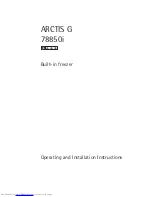
360142-D/D
15
i.Series® Models
6.2
Automatic Defrost Cycle
The number of programmed defrost events is dependent on environmental conditions and the frequency
of usage. The recommended number of daily defrost cycles is three to four, at even intervals. Defrost
events should take place when the freezer door is opened infrequently.
NOTE
Depending on the high temperature alarm setpoint and the actual temperature increase
during the defrost cycle, frequent door openings may trigger repeated high temperature
alarms.
The i.C³ monitoring and control system can perform a maximum of four defrost cycles per day. For
information in setting the system time and the time at which each defrost cycle occurs, refer to the i.C³
User Guide.
Defrost Event
On/Off
Default Time
1
On
12:00 AM
2
On
8:00 AM
3
On
4:00 PM
4
Off
6:00 PM
NOTE
There must be a minimum of four hours between defrost cycles.
6.3
External Monitoring Devices
The remote alarm interface is a relay switch with three terminals:
►
Common (COM)
►
Normally Open (NO)
►
Normally Closed (NC)
Terminals are dry contacts and do not supply voltage. Interface circuit is either normally open or normally
closed, depending on terminals used.
Requirements for your alarm system determine which alarm wires must connect to terminals.
NOTE
Do not connect any monitoring device that exceeds the maximum load capacity.
The terminals on the remote alarm interface have the following maximum load capacity:
►
0.5 A at 125 V (AC): 1 A at 250 V (DC)
6.3.1
Connect to Remote Alarm Interface
1
Switch AC ON/OFF switch OFF. Switch battery switch OFF.
2
On back of freezer, locate the remote alarm terminals.
3
Connect remote alarm wires to appropriate terminals, according to requirements for your alarm
system.
4
Use a cable tie to relieve strain on alarm wires (as necessary).
5
Switch battery switch ON. Switch AC ON/OFF switch ON.
6
Touch
Mute
to disable the high temperature alarm while freezer reaches operating temperature.
















































